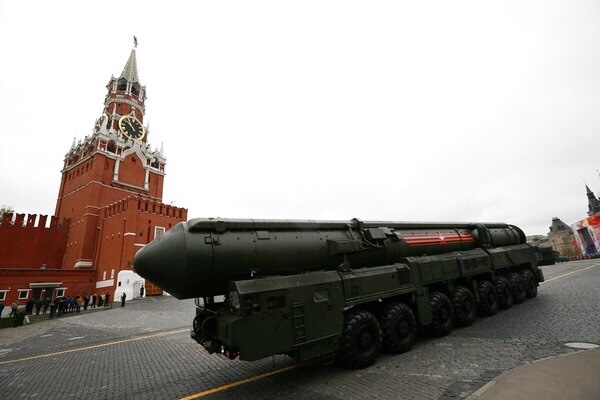
As Biden takes office, key nuclear and missile defense decisions loom
Aaron Mehta
WASHINGTON — When U.S. President-elect Joe Biden takes office, his national security team will have to work quickly to make calls on a number of key nuclear and missile defense decisions, according to a top outgoing Pentagon official.
Rob Soofer, who has served as deputy assistant secretary of defense for nuclear and missile defense policy since early in the Trump administration, told Defense News in a Jan. 5 interview that he expects a wide-ranging review of nuclear and missile defense issues from the new administration. But he is hopeful that technical reviews needed to keep programs on track will not be delayed in the process.
“Literally everything is on the table, so to speak,” Soofer said, noting there is a limited window before the budget must be produced, perhaps by mid-March. “They will likely alter President [Donald] Trump’s budget request for fiscal 2022 in some fashion. And I would hope that that they would wait until they conducted their Nuclear Posture Review and their Missile Defense Review before they took any precipitous steps with respect to the big modernization programs.”
“I think anything that reflects dollars and cents for the FY22 budget is going to have to have near-term consideration,” he added. “Funding for the Ground Based Strategic Deterrent and the nuclear certification of the F-35 — all these nuclear decisions are reflected in the budget request, and so in a sense they have to make a decision within months.”
While most policy decisions, such as questions about the no-first-use policy, “can wait,” Soofer said, a near-term policy decision does have to happen: figuring out the strategy for the New START nuclear pact, which expires in early February. The Biden team has two options to pursue with Russia: a one- or five-year extension.
Soofer, who took part directly in talks with Russia over the last year, believes that based on those talks, there is a real opportunity to get Russian tactical nuclear weapons included in a new version of the agreement.
“In order to take advantage of that opportunity, the Biden administration should not extend the New START treaty for five years,” Soofer urged. “If they do that, Russia will pocket that extension, walk away, and you’re never going to see [the Russians] again.”
Soofer’s view clashes with some in the arms control community. A Jan. 19 report from the Arms Control Association, focused on arms control priorities for the new administration, called for a five-year “unconditional” extension.
“There is no evidence that Russia is desperate to extend the treaty or that a shorter-term extension of New START would make Russia more likely to negotiate a follow-on agreement,” the authors wrote. “Nor is a one-year or two-year extension likely to be enough time to negotiate a new agreement. New START took ten months to negotiate and then about as long to bring into force. And that was at a time when the U.S.-Russia relationship was far less tense.”

A Russian Topol M intercontinental ballistic missile launcher rolls along Red Square during the Victory Day military parade in Moscow in 2017. (Alexander Zemlianichenko/AP)
Looking at the programmatic level, Soofer noted there are a number of big decisions on the horizon, with administration planners having to decide what is and isn’t funded in the near term as they produce the FY22 budget request.
One specific decision coming up soon is whether to approve Milestone B on the Defense Department’s replacement for the nuclear-capable cruise missile, the Long-Range Standoff weapon, or LRSO, a decision due in May.
The LRSO program has received a mixed reaction among Democrats, with efforts in 2015 and 2016 to outright cancel the program. Hillary Rodham Clinton, the Democratic presidential nominee during the 2016 election, had expressed skepticism about the program, leading to the prediction that her administration would try to cancel it.
Soofer acknowledged that the policy questions around LRSO are something that the Biden administration will have to “grapple with,” but urged decision-makers not to let that discussion hold up the Milestone B decision, as doing so could have major ramifications for the ability to execute the program.
“If they wait until they’re done thinking about this in a formal [Nuclear Posture Review] construct, which could take a year, they will not be able to make that [engineering and manufacturing development] EMD decision. So I would hope that there’s enough information amongst senior leadership to at least make an EMD decision,” Soofer said.
On the missile defense front, the biggest near-term question facing the new team is how to pursue the Next Generation Interceptor program, or NGI. In the FY21 National Defense Authorization Act, Congress ordered the Pentagon to build an interim homeland intercontinental ballistic missile defense interceptor, with delivery by 2026, just a few years before the NGI is expected to come online.
Congress did allow a waiver for the Pentagon to skip that interim capability should the department decide it’s unrealistic, but that decision will come due very early in the Biden administration’s tenure.
More broadly, Soofer said the “key question” on missile defense for the next administration is the question of whether to move forward with the Trump administration’s plan to add 20 Ground-Based Interceptors in the ground.
“They’re going have to make the key decision whether they’re going to continue with the 20 GBIs. If they do, then they’ll find out fairly quickly that the difference between an interim capability, maybe like a heavy [life-extension program] — the difference between that and the objective system, in terms of time, is maybe one or two years,” he said. “And you have to weigh that against a significant enhancement in capability that NGI gets you primarily through the fielding of multiple kill vehicles.
“All this is going to be very, very politicized. And the strategy and the technology behind it is going to be weighed.”
No comments:
Post a Comment